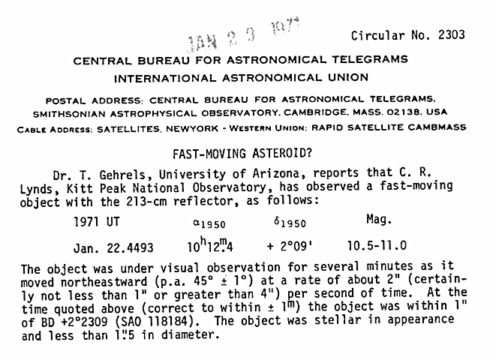An amateur astronomer thought he had found the true identity of a mystery object identified — and then lost — in 1971.
On the morning of January 22, 1971, astronomer C. Roger Lynds happened to be looking through the 84-inch telescope at Kitt Peak National Observatory when he noticed something moving. A starlike point was creeping northeastward across the constellation Sextans. Lynds estimated that it was magnitude 10.5 or 11 and was traveling 2 arcseconds per second. He followed it for several minutes and got an excellent position mark when it passed within about an arcsecond of an identifiable 9th-magnitude star. He recorded the time to the minute.
Lynds concluded that it was probably a small asteroid passing remarkably near Earth, something almost unknown at the time. It was lost and never seen again.

The sighting made the March 1971 Sky & Telescope. “Having always been fascinated by that account I read almost 50 years ago,” longtime subscriber John Rogers wrote last month, “I have routinely checked the Near Earth Asteroid database for a possible identification.” On January 26, 2020, the Minor Planet Electronic Circulars reported the discovery of a new near-Earth object passing by, designated 2020 BP8. “Propagating its orbit back in time reveals a close approach to the Earth on the date and time of Lynds’ observation,” Rogers noted. “Has this nearly 50-year-old mystery finally been solved?”
Apparently, no. The possible connection prompted a lot of calculating by members of the Minor Planet Mailing List, and it turns out that the orbit of 2020 BP8 misses the mark. The date matched up (with an uncertainty of a couple of days). The object's speed and direction of motion looked good. But, it turned out, the real 2020 BP8 would have appeared in a different part of the sky.
Moreover, 2020 BP8 turns out to be much too large. Bill J. Gray pointed out that if it had come close enough to appear to move so fast, it would have shone at about 1st magnitude, not 11th. The consensus was that Lynds’s 1971 object was likely a piece of space junk, either in a very high orbit (hardware from the U.S. or Soviet lunar missions might qualify), or perhaps it was near apogee in a lower but very elliptical orbit.

If there’s a lesson in this story, it’s to be aware of what statisticians call your “priors” — a crucial subtlety throughout science and everyday life that the mathematician Thomas Bayes first described and formalized in 1763. For instance, fairly often a coincidence will look so remarkable that coincidence seems almost impossible. But the things that you see and don’t see are always shaped by prior selections and conditions, often without your noticing. If you compare vast numbers of newly discovered near-Earth asteroids’ orbits to a given past sighting, you’re likely to see a rare good fit that, if taken by itself, would look convincing. At the same time, by 1971 a lot of space junk was up there. It’s a lesson that applies widely.
 0
0
Comments
You must be logged in to post a comment.